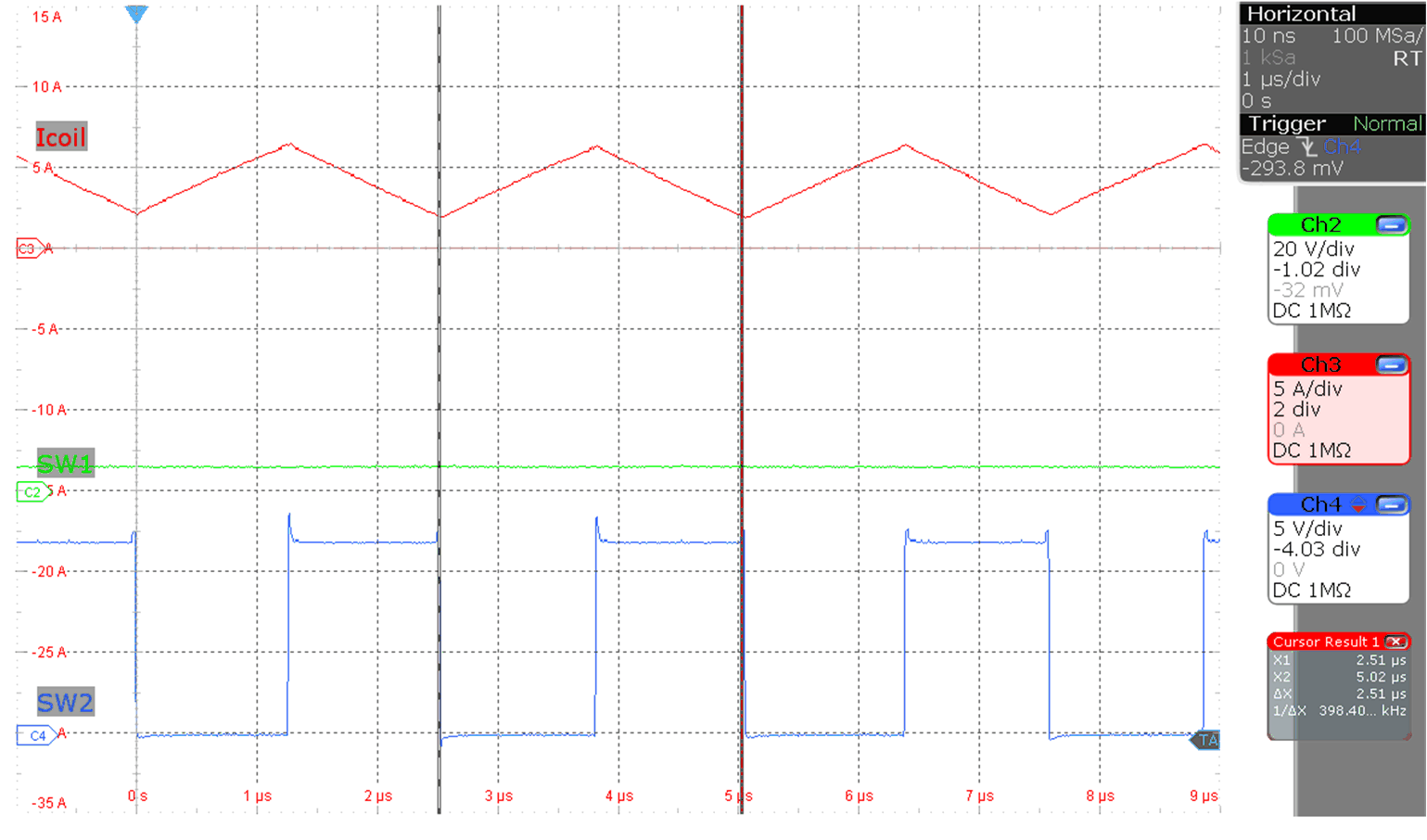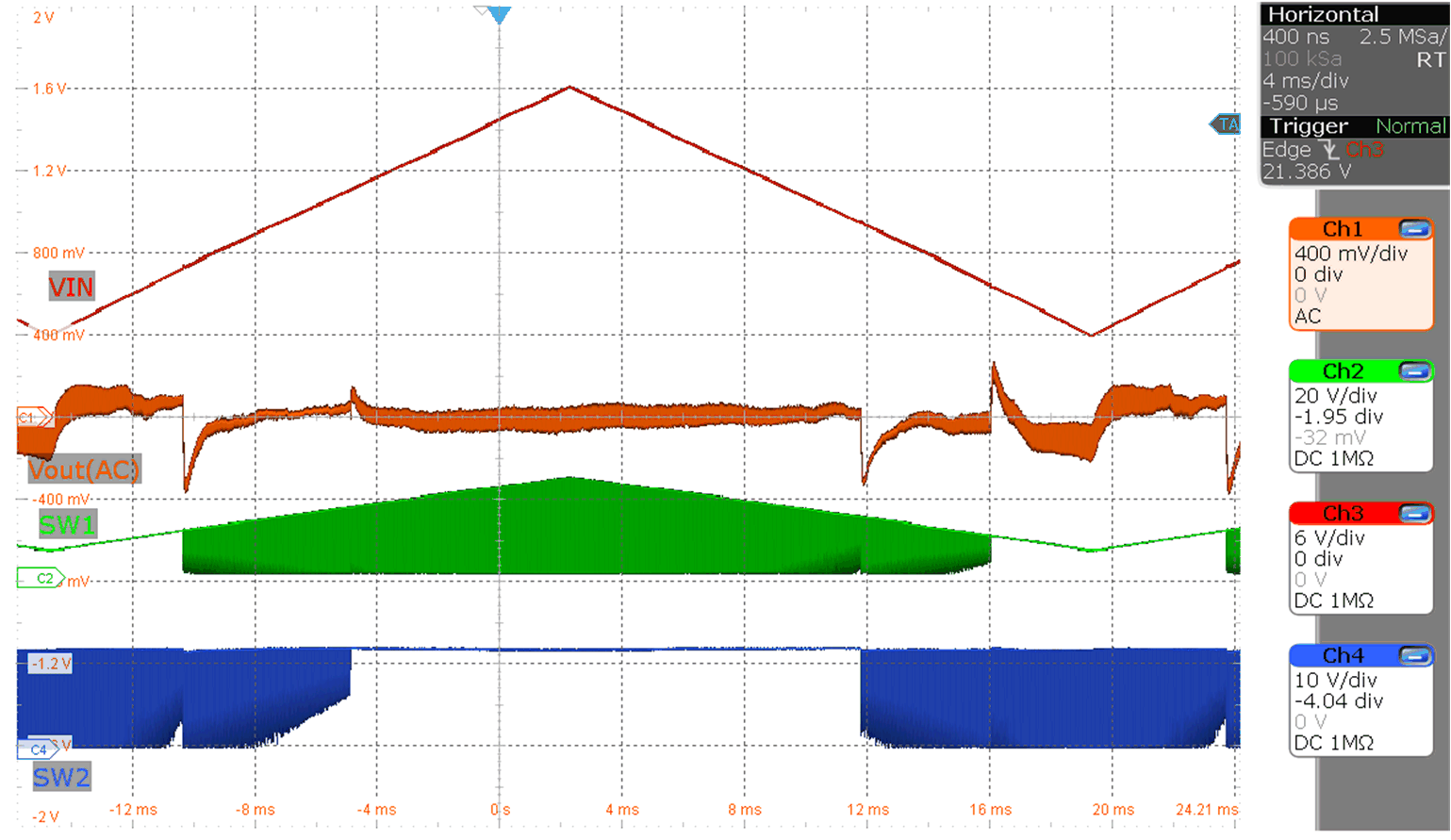JAJSOR1E June 2022 – August 2024 LM5177
PRODUCTION DATA
- 1
- 1 特長
- 2 アプリケーション
- 3 概要
- 4 Pin Configuration and Functions
- 5 Specifications
- 6 Parameter Measurement Information
-
7 Detailed Description
- 7.1 Overview
- 7.2 Functional Block Diagram
- 7.3
Feature Description
- 7.3.1 Power-On Reset (POR System)
- 7.3.2 Buck-Boost Control Scheme
- 7.3.3 Power Save Mode
- 7.3.4 Supply Voltage Selection – VMAX Switch
- 7.3.5 Enable and Undervoltage Lockout
- 7.3.6 Oscillator Frequency Selection
- 7.3.7 Frequency Synchronization
- 7.3.8 Voltage Regulation Loop
- 7.3.9 Output Voltage Tracking
- 7.3.10 Slope Compensation
- 7.3.11 Configurable Soft Start
- 7.3.12 Peak Current Sensor
- 7.3.13 Current Monitoring and Current Limit Control Loop
- 7.3.14 Short Circuit - Hiccup Protection
- 7.3.15 nFLT Pin and Protections
- 7.3.16 Device Configuration Pin
- 7.3.17 Dual Random Spread Spectrum – DRSS
- 7.3.18 Gate Driver
- 7.4 Device Functional Modes
-
8 Application and Implementation
- 8.1 Application Information
- 8.2
Typical Application
- 8.2.1 Design Requirements
- 8.2.2
Detailed Design Procedure
- 8.2.2.1 Custom Design with WEBENCH Tools
- 8.2.2.2 Frequency
- 8.2.2.3 Feedback Divider
- 8.2.2.4 Inductor and Current Sense Resistor Selection
- 8.2.2.5 Slope Compensation
- 8.2.2.6 Output Capacitor
- 8.2.2.7 Input Capacitor
- 8.2.2.8 UVLO Divider
- 8.2.2.9 Soft-Start Capacitor
- 8.2.2.10 MOSFETs QH1 and QL1
- 8.2.2.11 MOSFETs QH2 and QL2
- 8.2.2.12 Frequency Compensation
- 8.2.2.13 External Component Selection
- 8.2.3 Application Curves
- 8.3 System Examples
- 9 Power Supply Recommendations
- 10Layout
- 11Device and Documentation Support
- 12Revision History
- 13Mechanical, Packaging, and Orderable Information
パッケージ・オプション
メカニカル・データ(パッケージ|ピン)
- DCP|38
サーマルパッド・メカニカル・データ
- DCP|38
発注情報
8.2.3 Application Curves
 Figure 8-2 Start-up waveform standby to active operation
Figure 8-2 Start-up waveform standby to active operation (MODE = V(VCC), Vo = 12 V, Io = 0 A, V(VIN) = 12 V)
 Figure 8-4 Inductor current
buck-boost operation
Figure 8-4 Inductor current
buck-boost operation (MODE = V(VCC), Vo = 12 V, Io = 0 A, V(VIN) = 12 V)
 Figure 8-6 Inductor current boost
operation
Figure 8-6 Inductor current boost
operation (MODE = 0 V, Vo = 12 V, Io = 10 mA, V(VIN) = 6 V)
 Figure 8-8 Inductor current buck
operation
Figure 8-8 Inductor current buck
operation (MODE = 0 V, Vo = 12 V, Io = 10 mA, V(VIN) = 24 V)
 Figure 8-10 Efficiency Versus IO
Figure 8-10 Efficiency Versus IO
(MODE = 0V Vo = 12 V)
 Figure 8-12 Efficiency Versus IO in Boost Mode
Figure 8-12 Efficiency Versus IO in Boost Mode(VIN = 5 V, Vo = 12 V)
 Figure 8-14 Efficiency Versus IO in Buck Mode
Figure 8-14 Efficiency Versus IO in Buck ModeVIN = 24 V, Vo = 12 V)
 Figure 8-3 Inductor current boost
operation
Figure 8-3 Inductor current boost
operation (MODE = V(VCC), Vo = 12 V, Io = 0 A, V(VIN) = 6 V)
 Figure 8-5 Inductor current buck
operation
Figure 8-5 Inductor current buck
operation (MODE = V(VCC), Vo = 12 V, Io = 0 A, V(VIN) = 24 V)
 Figure 8-7 Inductor current
buck-boost operation
Figure 8-7 Inductor current
buck-boost operation (MODE = 0 V, Vo = 12 V, Io = 10 mA, V(VIN) = 12 V)
 Figure 8-9 Input voltage ramp from 6V
to 24V
Figure 8-9 Input voltage ramp from 6V
to 24V (MODE = V(VCC), Vo = 12 V, Io = 6A
 Figure 8-11 Efficiency Versus IO
Figure 8-11 Efficiency Versus IO
(MODE = VCC Vo = 12 V)
 Figure 8-13 Efficiency Versus IO in Buck-Boost Mode
Figure 8-13 Efficiency Versus IO in Buck-Boost ModeVIN = 12 V, Vo = 12 V)
 Figure 8-15 Efficiency Versus VIN
Figure 8-15 Efficiency Versus VIN
(Vo = 12 V, IO = 6 A)